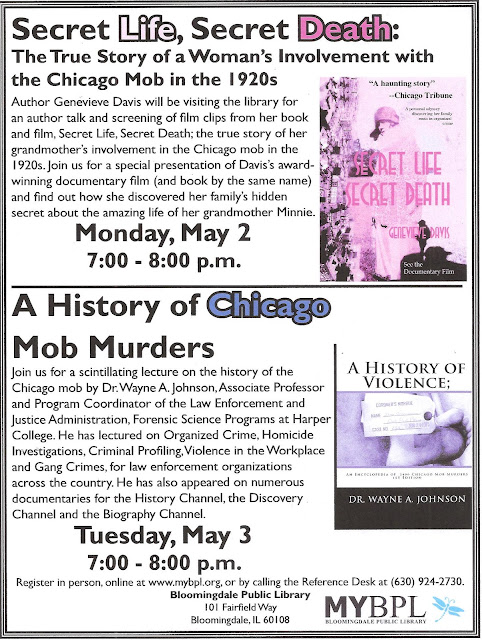Recently, I had the privilege to speak at the Westchester, Illinois Library on March 19th. What a great group. I want to thank Patrick Callahan for arranging this and his hospitality.
My next appearance will be at:

ORGANISED crime gangs have ways to avoid their operations being shut down by police or having gang members locked away. One way is to hire legal minds to defend them in court or to exploit loopholes in the law to make sure their nefarious businesses continue as usual. For this lawyers
are often richly rewarded. However, dealing with the underworld can have fatal consequences.
are often richly rewarded. However, dealing with the underworld can have fatal consequences.
Like lawyer Joe Acquaro who was gunned down this week in Melbourne. But before he was killed he was warned: “Don’t be a gangster, be a lawyer”.
It is a lesson other mob-connected lawyers learnt the hard way. Although many have avoided a nasty end.
When Chicago mob boss Al Capone needed legal advice he turned to Edward “Easy Eddie” O’Hare. Born in St Louis, Missouri, in 1893 to parents with Irish heritage, O’Hare put himself through law school, passing the bar exam in 1923. He got work at a St Louis law firm, where one of their clients was greyhound racing commissioner Owen P. Smith, who had patented the electric rabbit.

When Smith died in 1927 O’Hare acquired the patent from Smith’s widow and invested in racing tracks, bringing him into contact with the underworld.
Al Capone met with O’Hare to get rights to the rabbit for his track in Illinois, where dog racing was illegal at the time. O’Hare also helped Capone fight legal action against his tracks in the courts. Easy Eddie became Capone’s business partner in race tracks around the country and O’Hare also arranged Capone’s business affairs to avert prosecution. O’Hare was well rewarded, but as authorities began to close in on Capone, O’Hare realized he could be dragged down with the gangster.
In 1930 the lawyer provided evidence against the mobster leading to a trial for tax evasion. Unaware of the betrayal, Capone was confident of getting off lightly, with legal advice from his new lawyers Michael Ahern and Albert Fink. In 1933 Capone was sentenced to 11 years.

Capone’s health deteriorated in prison and on November 16, 1939, he was released. Just a few days earlier, on November 8, O’Hare was shot dead in his car. The killers were never caught.
Easy Eddie’s son Edward “Butch” O’ Hare served in WWII, winning the Medal of Honour and dying in action in 1943. Chicago’s airport was renamed O’Hare in 1949 in his honour.
Another infamous mob lawyer was Frank Ragano. Born in 1923 to Sicilian parents he served as a naval airman in WWII, winning a bronze star. After the war he studied law and was admitted to the bar in 1952. In 1954 he was recruited to work on a case concerning mob boss Santo Trafficante’s illegal lottery racket and became friends with Trafficante. He would also later represent Miami boss Carlos Marcello.

When Fidel Castro took over in Cuba in 1959, he closed down mafia casinos and had Trafficante arrested, Ragano negotiated for the gangster’s release. He also represented Jimmy Hoffa when the union boss was on charges of corruption in the ’60s.
But Ragano had problems with tax evasion that saw him disbarred in the ’70s, causing a rift between him and Trafficante. It was later healed and after being readmitted to the bar in the ’80s he successfully defended Trafficante in a racketeering case. But when Trafficante died in 1987 it was his new best friend and legal adviser Henry Gonzalez who announced the death to the media.

Ragano was abandoned by the mob and served time in prison in the ’90s for tax evasion. In 1992 he claimed to have information about the mob’s involvement in the assassination of President John F. Kennedy, claims which he repeated in his autobiography Mob Lawyer, published in 1994. He evaded mob execution and died in his sleep in 1998.
New York lawyer Bruce Cutler also became notorious in the ’80s for defending crime boss John Gotti. But he was disqualified from one trial because of evidence that he had connections with the Cosa Nostra and knew of Gotti’s criminal activities. He was suspended in 1995 but in 1999 returned to the limelight defending Gotti’s son. He is still practising law today.

He was involved in drug trafficking and a range of other crimes with the Calabrian Mafia in Australia. An attempt on his life was thwarted in 2004 but he was gunned down in 2006 during Melbourne’s “Underbelly” gangland wars just before he was due to stand trial for his part in the murder of crime figure Carl Williams.



 The heroic goodbyes shared by Annette Bening as Virginia Hill and Warren Beatty as Bugsy Siegel in the movie Bugsy were a romantic fantasy.
The heroic goodbyes shared by Annette Bening as Virginia Hill and Warren Beatty as Bugsy Siegel in the movie Bugsy were a romantic fantasy.  Virginia Hill's hard-bitten story was a kind of mirror inversion of Breakfast at Tiffany's with Audrey Hepburn. Photo: Supplied
Virginia Hill's hard-bitten story was a kind of mirror inversion of Breakfast at Tiffany's with Audrey Hepburn. Photo: Supplied Annette Bening's Virginia Hill in Bugsy was an alluring firecracker. Photo: Supplied
Annette Bening's Virginia Hill in Bugsy was an alluring firecracker. Photo: Supplied

